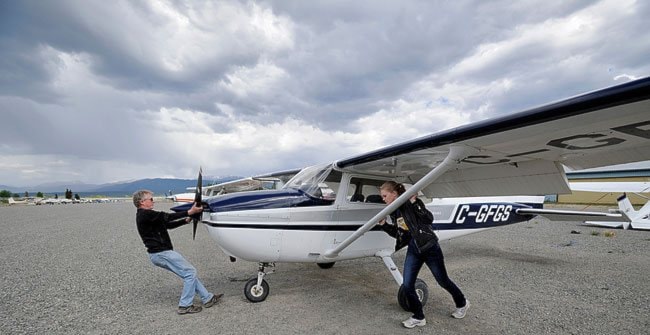The engine coughs twice before the little Cessna’s pistons snarls to life in the parking lot at Whitehorse Air Services.
Student pilot Brooke Nielsen flips through her pre-flight checklist, double- and triple-checking everything with a pilot’s meticulousness.
“Whitehorse airport, this is Foxtrot Golf Sierra requesting runway access,” she says as tiny droplets of rain begin to strike the plane’s windscreen.
“Watch the outflow from that shower over there,” says flight instructor Kelly Collins, pointing to a large rainstorm advancing across the valley.
“It’ll make you work.”
The air traffic controller’s voice crackles over the radio, giving the two pilots the clearance they need to pull the plane out onto the tarmac and line up for the take off.
“OK, off we go. Let ‘er rip,” Collins says.
Nielsen opens up the throttle and the plane lurches aggressively down the runway.
Collins spends much of his time circling around above downtown Whitehorse with rookie pilots. He guides them with ease until they have the confidence to take the controls.
“The single most difficult skill to learn as a pilot is landing. You have to juggle so many different skills at once,” Collins says.
“With me, they take the controls a little on the first flight and by the third they’re flying pretty much by themselves.”
Collins has been helping Whitehorse students get their wings since he first arrived in the territory in 1985. There’s a wall in his unassuming office covered with photos of his students and their planes. Collins ran out of wall space for all the photos, though he still keeps a list of names and dates of everyone he’s graduated, more than 160 pilots in total.
“There are no astronauts, but I’ve got guys in FedEx, Air North, Alcan, smaller companies around the North.”
He’s even helped pilots get their military wings, no easy feat given that 75 per cent of those who try ultimately fail.
In February, that legacy earned Collins an unexpected honour. On Valentine’s Day, his wife surprised him at what he thought would be a quiet romantic dinner. Instead, he was met by a crowd of his friends and coworkers who announced that he was getting one of the Yukon government’s highest aviation honours, the Order of Polaris, as recognition for all the work he’s put in training Yukon aviators.
“It was a total surprise to me, which is impressive because of how much work it took to. My wife recruited a lot of people to help, but I didn’t know a thing about it,” he says.
Collins first took to the skies as a teenager outside Chilliwack. He grew up with a dream of flying and paid for his flying lessons by flipping burgers. He flew privately for 10 years before coming up to Whitehorse as a 26-year-old rookie instructor.
He’s taken a few breaks from the North to teach flying in the military in Manitoba, and spent a year in New Brunswick as well, but in 2001 he came back to Whitehorse because it’s home, he says.
Back in the Cessna, Collins is going through landings with Nielsen, doing touch-and-goes down the runway before having her circle back over Whitehorse for another pass. The weather is rough, and the little plane is being tossed about like a toy.
Nielsen banks the Cessna over the Yukon River, and Collins points to a rainbow below them.
“Don’t fly through that,” he says, with a stern voice.
“You’ll get colours all over the plane, and they’re really hard to get off,”
As she comes in for another landing, the crosswind that Nielsen has been struggling with all afternoon suddenly drops away, and the plane starts drifting slightly to the left. Collins takes the controls for a minute, guiding his student and the plane back towards the centre line.
The rubber screeches as the right-hand wheel grips the tarmac. The plane yaws a little as all three wheels go down. Nielsen slows the plane, sticks the landing and then spins up the throttle again, preparing for another takeoff.
“Let the plane tell you when it wants to fly, not the other way ‘round,” Collins instructs.
“The airplanes live a hard life. They get hammered onto the runway quite a bit. I’m very conservative. I don’t send anybody out there if I feel there’s any chance they won’t get home in one piece. So far it’s paid off,” Collins says.
It seems like a rough couple of landings, but Nielsen is doing them with only 15 hours of flight time under her belt and by the end of the lesson she’s already much smoother. The fact that she’s landing and taking off at all in strong crosswinds and a windshield streaming with rain is almost unheard of, Collins says.
He normally wouldn’t let a rookie with Nielsen’s amount of experience go up in weather like this, but he was confident she could handle it.
“This is amazing. This is way, way better than someone would normally be with those hours,” Collins says, smiling.
Aside from the odd student “bending” the occasional plane with rough landings, Whitehorse Air Services has never had a wrecked plane, and Collins himself has never even scratched the paint on one.
“Flying is also very intolerant of poor judgment. I always try to instill that in my students,” he says.
“Something going wrong is never a single event. There’s always a series of contributing events which you should see coming. If you got caught by surprise, you haven’t had your eyes open.”
After 27 years of training Yukon pilots, Collins is retiring. He plans to do a little freelance instructing on the side, though. He loves seeing new pilots get their wings.
“It always feels good when you finally kick them out of the nest.”
Contact Jesse Winter at
jessew@yukon-news.com
